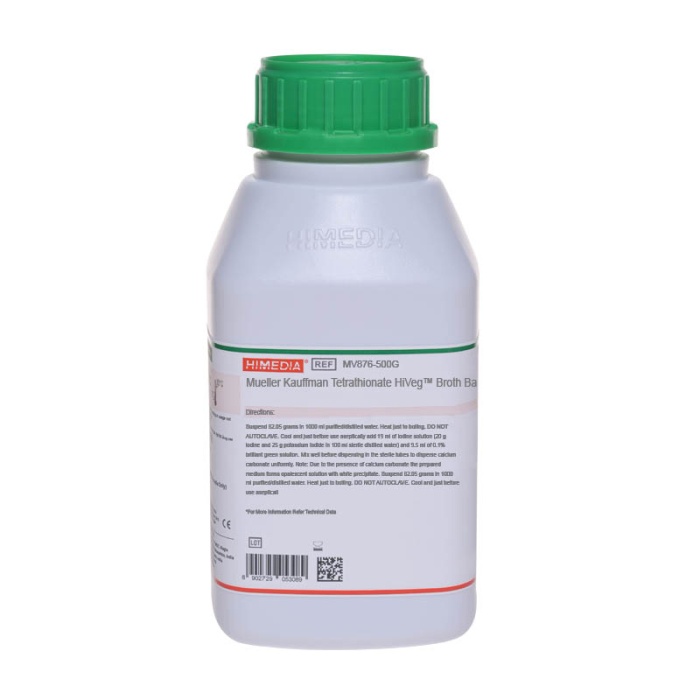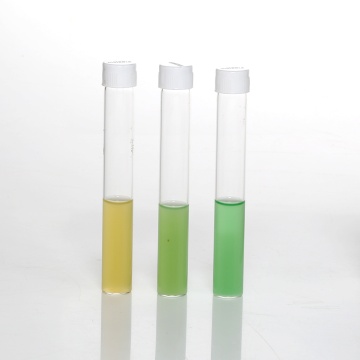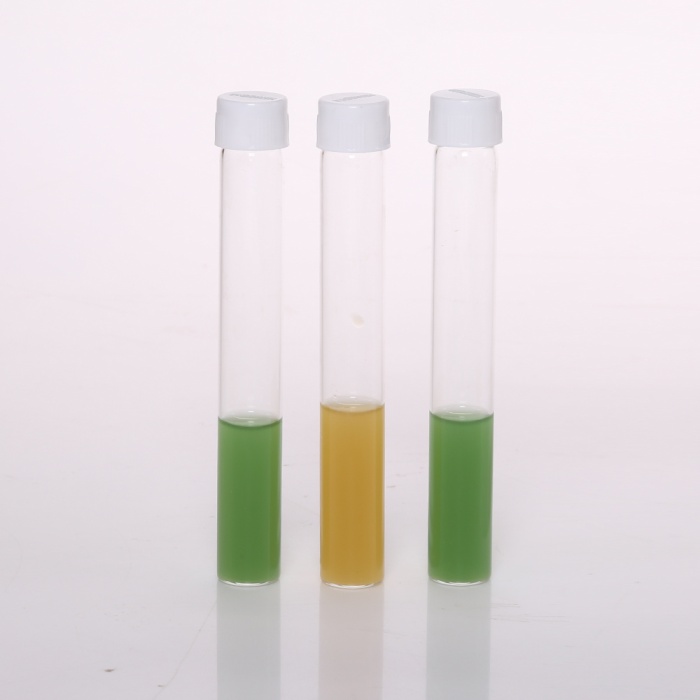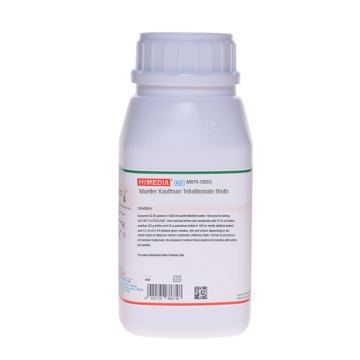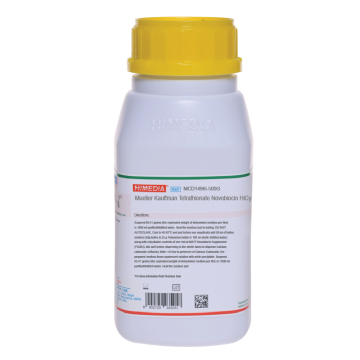 Your enquiry has been submitted
Your enquiry has been submitted
Mueller Kauffman Tetrathionate Novobiocin Broth Base
Intended Use
Recommended for improved enrichment and isolation of Salmonellae. The composition and performance criteria of this media are as per the specification laid down in ISO 6579-1:2017 and ISO 11133:2014 (E) /Amd. : 2020.
Composition**
| Ingredients | g / L |
|---|---|
| HM extract# | 4.300 |
| Enzymatic digest of casein | 8.600 |
| Ox bile for bacteriological use | 4.780 |
| Sodium chloride (NaCl) | 2.600 |
| Calcium carbonate (CaCO3) | 38.700 |
| Sodium thiosulphate, pentahydrate (Na2S2O3 5H2O) | 47.800 |
| Brilliant green | 0.0096 |
Final pH (at 25°C): 8.0±0.2
Supplements to be added after autoclaving
| Novobiocin sodium salt | 0.040 g |
| $ Iodine-iodide solution | 20.00 ml |
| Iodine | 4.000 g |
| Potassium iodide (KI) | 5.000 g |
**Formula adjusted, standardized to suit performance parameters # Equivalent to Meat extract ## Equivalent to Ox bile ### Equivalent to Tryptone (Enzymatic digest of casein) $ To be added but not provided (To be freshly prepared)
Directions
Suspend 89.42 gram (equivalent weight of dehydrated medium per litre) in 1000 ml purified/ distilled water. Heat the medium just to boiling. DO NOT AUTOCLAVE. Cool to 45-50°C and just before use aseptically add rehydrated contents of 1 vial of MKTT Novobiocin Supplement (FD203) and 20 ml of iodine-iodide solution (20 gram iodine and 25 gram potassium iodide in 100 ml sterile distilled water). Mix well to disperse calcium carbonate uniformly before dispensing in sterile tubes.
Note: Due to presence of calcium carbonate, the prepared media forms opalescent solution with white precipitate.
Principle And Interpretation
The examination of various types of food products for Salmonella requires methods different from those used in clinical laboratories. The need for such method is due to the generally low numbers of Salmonellae in foods and the frequently poor physiological state of these pathogens following exposure to stressful conditions during food processing or storage. Injured Salmonella are resuscitated in non-selective broth medium, which facilitates detection of sublethally injured Salmonella. The ideal pre-enrichment broth should provide for the repair of cell damage, dilute toxic or inhibitory substances and nutritive enough to favour growth of Salmonella.
Mueller (1) recommended Tetrathionate Broth as a selective medium for the isolation of Salmonella. Kauffman (2) modified the formula to include ox bile and brilliant green as selective agents to suppress bacteria such as Proteus species. The British Standard Specification specifies Brilliant Green Tetrathionate Broth for isolating Salmonella from meat, meat products, and from poultry and poultry products (3). ISO committee has also recommended this pre-enrichment medium for the detection of Salmonella species from food stuffs and other materials (4). Selectivity is conferred by tetrathionate (from the reaction of thiosulphate and iodine).
Using more than one selective broth increases the isolation of Salmonella from samples with multiple serotypes (1). This medium contains Tryptone and HM extract as sources of carbon, nitrogen, vitamins and minerals. Bile and added brilliant green are selective agents, which inhibit gram-positive and other gram-negative organisms. Calcium carbonate is the buffer. Sodium chloride maintains osmotic equilibrium. Sodium thiosulphate is a source of sulfur. The tetrathionate (S4O6) anions constitute the principle selective agent in these enrichment media. Organisms other than Salmonellae, such as Morganella morganii and some Enterobacteriaceae may grow in the medium. Therefore, confirmatory tests should be carried out on all presumptive Salmonella colonies that are recovered. Method (5).
Type of specimen
Food samples including milk and milk products, in animal feed, in animal faeces, and in environmental samples from the primary production stage.
Specimen Collection and Handling
Processing : ISO 6579-1:2017 (4)
Pre-enrichment: Samples (25 gram in 225 ml) are preenriched in Buffered Peptone Water (M1494I) and incubated at 34°C to 38°C for 18 h ± 2 hours.
Selective enrichment: 0.1 ml of pre-enriched sample is inoculated in 10 ml RVS Broth (M1448I) or MSRV Agar (M1428I) and incubated at 41.5 ± 1°C for 24 ± 3 hours and 1 ml of culture is inoculated in MKTTn broth (M1496I) and incubated at 37± 1°C for 24 ± 3 hours.
Isolation: The culture thus obtained is then plated on XLD Agar, Modified (M031I) and incubated at 37± 1°C for 24 ± 3 hours. Simultaneously plating on second isolation agar is carried out.
Confirmation: Biochemical and serological tests are performed for confirmation.
Warning and Precautions
Read the label before opening the container. Wear protective gloves/protective clothing/eye protection/ face protection. Follow good microbiological lab practices while handling specimens and culture. Standard precautions as per established guidelines should be followed while handling specimens. Safety guidelines may be referred in individual safety data sheets.
Limitations
- The complete medium is unstable and should be used immediately. After incubation, it is permissible to store the selective enrichment medium at 5°C for a maximum of 72 h.
- Individual organisms differ in their growth requirement and may show variable growth patterns in the medium.
- Each lot of the medium has been tested for the organisms specified on the COA. It is recommended to users to validate the medium for any specific microorganism other than mentioned in the COA based on the user’s unique requirement.
- Confirmatory tests should be carried out on all presumptive Salmonella colonies that are recovered.
Performance and Evaluation
Performance of the medium is expected when used as per the direction on the label within the expiry when stored at period recommended temperature.
Quality Control
Appearance Cream to greenish yellow homogeneous free flowing powder
Colour and Clarity of prepared medium Light green coloured opalescent solution forms with heavy white precipitate
Reaction Reaction of 8.93% w/v aqueous solution at 25°C. pH : 8.0±0.2
pH 7.80-8.20
Cultural Response
Productivity: Cultural response was observed after an incubation at 37 ±1°C for 24 ± 3 hours with added sterile 20ml iodine solution and MKTT Supplement (FD203). Further subculture is carried out on XLD Agar, Modified (M031I) and incubated at 37 ±1°C for 24 ± 3 hours.
| Organism | Inoculum (CFU) | Recovery on XLD Agar (M031I) | Colour of colony on XLD Agar (M031I) |
|---|---|---|---|
| Salmonella Enteritidis ATCC 13076 (00030*) +Escherichia coli ATCC 8739 (00012*) + Pseudomonas aeruginosa ATCC 27853 (00025*) | 50-100 >=104 >=104 | >10 colonies | red colonies w/ black centre |
| Salmonella Typhimurium ATCC 14028 (00031*) + Escherichia coli ATCC 25922 (00013*) + Pseudomonas aeruginosa ATCC 27853 (00025*) | 50-100 >=104 >=104 | >10 colonies | red colonies w/ black centre |
Selectivity: Cultural characteristics observed after an incubation at 37±1°C for 24±3 hours with added sterile 20ml iodine solution and MKTT Supplement (FD203). Further subculture is carried out on Tryptone Soya Agar (M290) and incubated at 37±1°C for 24 ± 3 hours.
| Organism | Inoculum (CFU) | Growth | Recovery on Tryptone Soya Agar |
|---|---|---|---|
| Escherichia coli ATCC 8739 (00012*) | >=104 | partial inhibition | <=100 colonies |
| Escherichia coli ATCC 25922 (00013*) | >=104 | partial inhibition | <=100 colonies |
| Enterococcus faecalis ATCC 29212(00087*) | >=104 | inhibition - partial inhibition | <10 colonies |
| Enterococcus faecalis ATCC 19433 (00009*) | >=104 | inhibition - partial inhibition | <10 colonies |
Key: (*) - Corresponding WDCM Numbers
Storage and Shelf Life
Store between 10-30°C in a tightly closed container and use freshly prepared medium. Use before expiry date on the label. On opening, product should be properly stored dry, after tightly capping the bottle in order to prevent lump formation due to the hygroscopic nature of the product. Improper storage of the product may lead to lump formation. Store in dry ventilated area protected from extremes of temperature and sources of ignition. Seal the container tightly after use. Product performance is best if used within stated expiry period.
Disposal
User must ensure safe disposal by autoclaving and/or incineration of used or unusable preparations of this product. Follow established laboratory procedures in disposing of infectious materials and material that comes into contact with sample must be decontaminated and disposed of in accordance with current laboratory techniques (6,7).
Reference
- Mueller L., 1923, C. R. Soc. Biol., (Paris) 89:434.Harvey R. W. S. and Price T. S., 1976, J. Hyg. Camb., 77:333.
- Kauffman F., 1935, Ztschr. F. Hyg., 117:26.
- Public Health Laboratory Service, 1974, Monograph Series No. 8, Public Health Laboratory Service, London, England.
- Microbiology of the food chain — Horizontal method for the detection, enumeration and serotyping of Salmonella — Detection of Salmonella spp. ISO 6579-1:2017
- Microbiology of food,animal feeding stuffs and water- Preparation, production,storage and performance testing of culture media, EN ISO 11133:2014 (E) /Amd. :2020 .
- Isenberg, H.D. Clinical Microbiology Procedures Handbook 2nd Edition.
- Jorgensen, J.H., Pfaller, M.A., Carroll, K.C., Funke, G., Landry, M.L., Richter, S.S and Warnock., D.W. (2015) Manual of Clinical Microbiology, 11th Edition. Vol. 1.
| Product Name | Mueller Kauffman Tetrathionate Novobiocin Broth Base |
|---|---|
| SKU | M1496I |
| Product Type | Regular |
| Physical Form | Powder |
| Origin | Animal |
| Packaging type | HDPE |
| References | 1.Harvey R. W. S. and Price T. S., 1976, J. Hyg. Camb., 77:333.2.Isenberg, H.D. Clinical Microbiology Procedures Handbook 2nd Edition. 3.Jorgensen,J.H., Pfaller, M.A., Carroll, K.C., Funke, G., Landry, M.L., Richter, S.S and Warnock., D.W. (2015)Manual of Clinical Microbiology, 11th Edition. Vol. 14.Kauffman F., 1935, Ztschr. F. Hyg., 117:2 |
| Customized Product Available | No |





